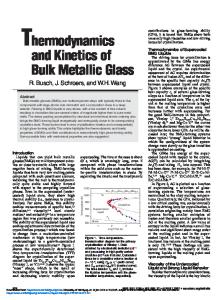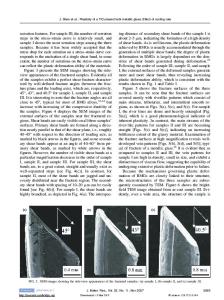Correlation Between Plasticity and Atomic Structure Evolution of a Rejuvenated Bulk Metallic Glass
- PDF / 1,857,601 Bytes
- 7 Pages / 593.972 x 792 pts Page_size
- 95 Downloads / 347 Views
INTRODUCTION
BULK metallic glasses (BMGs) have received significant attention because of their unique properties, such as a large elastic limit and high strength.[1,2] However, the inherent amorphous structure of BMGs leads to their brittleness at room temperature.[3] For this reason, several approaches have been developed by researchers to improve the plasticity of BMGs.[4–6] Among them, rejuvenation, a process that tunes the energy state and enhances the free volume in the structure, has attracted much interest.[7–9] Cryothermal treatment is one of the rejuvenation processes increasing the internal energy of MGs without induction of any anisotropy in the microstructure. For
MAJID SAMAVATIAN is with the Department of Materials Engineering, Science and Research Branch, Islamic Azad University, Ashrafi St., Ferdos Blvd., Tehran, 1477893855 Iran. Contact e-mail: [email protected] REZA GHOLAMIPOUR is with the Department of Advanced Materials and Renewable Energy, Iranian Research Organization for Science and Technology (IROST), Sh. Ehsani Rad St., Enqelab St., Parsa Sq., Ahmadabad Mostoufi Rd., Azadegan Highway, Tehran, 3313193685 Iran. Contact e-mail: [email protected] AHMAD ALI AMADEH is with the School of Metallurgy and Materials Engineering, College of Engineering, University of Tehran, 16th Azar St., Enghelab Sq., Tehran, 1417466191 Iran. SHAMSODDIN MIRDAMADI is with the School of Metallurgy and Materials Engineering, Iran University of Science and Technology (IUST), Narmak St., Tehran, 1684613114 Iran. Manuscript submitted March 27, 2019.
METALLURGICAL AND MATERIALS TRANSACTIONS A
the first time, Ketov et al.[10] proposed a cryothermal cycling method for a number of MGs and BMGs. According to their work, it is suggested that the heterogeneous structure of a glassy alloy induces internal stresses during the cycling and causes irreversible local atomic rearrangement.[10,11] In another work, Shang et al.[12] used molecular dynamics (MD) simulation to model the rejuvenation of a binary MG under cryogenic cycling. They found that the heterogeneous nature of the amorphous structure triggers local shear transformations and intensifies disordering in the MG. Moreover, the simulation results, done by Priezjev,[13,14] confirmed the heterogeneity effect and showed that the structural transition to a disparate energy states goes along with non-affine rearrangement of atomic clusters. Nevertheless, the experimental works have been continued by other researchers to develop Ketov’s theory. For example, Guo et al.[15,16] studied the effects of cryogenic cycling on BMGs and declared that the rejuvenation mechanism may be related to the influence of generated internal stress on the atomic-level core-shell heterogeneous microstructure of BMG. Song et al.[17] revealed that although the cryothermal cycling leads to the increment of plasticity, the thermal stability maintains the same level. Further works also indicated that cryothermal treatment induces both rejuvenation and relaxation in the BMG.[18] The type of event is ass
Data Loading...











